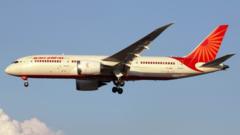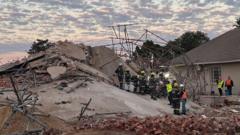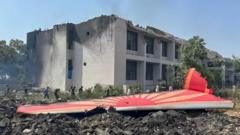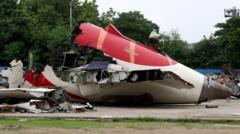The tragic crash of Air India's Boeing 787 Dreamliner has placed scrutiny on the aircraft’s safety record and production practices, with whistleblowers raising alarms over quality control issues. While Boeing touts its safety credentials, the clash between innovation and production standards has reignited debates over air travel safety.
Concerns Loom Over Boeing's 787 Dreamliner After Air India Crash

Concerns Loom Over Boeing's 787 Dreamliner After Air India Crash
As investigations continue into the recent Air India crash, concerns surrounding the safety of Boeing's 787 Dreamliner are intensifying, highlighting whistleblower allegations and production challenges.
After the tragic Air India crash that took place shortly after take-off, resulting in at least 270 fatalities, the Boeing 787 Dreamliner—a model long heralded as one of the safest flying—faces newfound scrutiny. Flight 171's sudden incident has sparked questions about the aircraft, which has operated for nearly 15 years without significant accidents, carrying over a billion passengers. There are more than 1,100 Dreamliners in service globally.
However, the 787's production history is marred with allegations of quality control failures. Whistleblowers have flagged significant concerns about manufacturing standards, claiming that substandard aircraft parts have made their way into service. Despite Boeing's denial of these claims, ongoing investigations are searching for the cause of the recent disaster with recovered flight data.
The Dreamliner’s inception was a response to rising fuel prices and the fallout from the 9/11 attacks on the aviation industry. Initially conceived as the Sonic Cruiser—emphasizing speed—the design was pivoted to a fuel-efficient long-haul aircraft, setting a new benchmark for airlines to pursue point-to-point travel instead of relying solely on larger high-capacity jets like Airbus's A380 superjumbo.
Although the 787 was considered cutting-edge due to its composite materials and innovative efficiency, early operational issues, including battery fires that temporarily grounded the fleet in 2013, raised concerns. In subsequent years, quality control problems persisted, culminating in a series of manufacturing defects that disrupted deliveries and prompted investigation.
Foremost among whistleblower accounts was John Barnett, a former quality manager, who raised alarms about the pressures to expedite production possibly compromising safety. His claims stirred controversy, particularly when he asserted that defective parts were being fitted to planes under time constraints. The FAA corroborated some of these concerns, acknowledging lapses in tracking components, though Boeing minimized the impact on flight safety.
Other whistleblowers, like Cynthia Kitchens and Sam Salehpour, echoed similar fears, warning about risks of faulty wiring and shortcuts taken during manufacturing. Boeing continues to assert that these claims do not compromise the integrity of the Dreamliners currently operating worldwide.
With pressure on Boeing’s corporate culture amplified after previous crises surrounding the 737 Max, the company is undertaking comprehensive evaluations to ensure safety and quality. Nevertheless, opinions are divided on the implications of past production issues, as experts debate whether real, systemic threats have manifested in the existing fleet.
Despite the uncertainty surrounding the Air India crash, aviation specialists affirm that the 787 maintains a commendable safety track record, insisting that any severe issues would likely have materialized by now. The investigation continues as industry stakeholders and the public await clarity on the tragic incident, with hopes that resolution will bolster confidence in air travel safety.




















